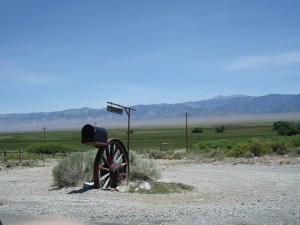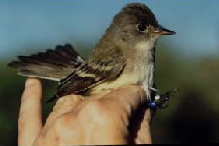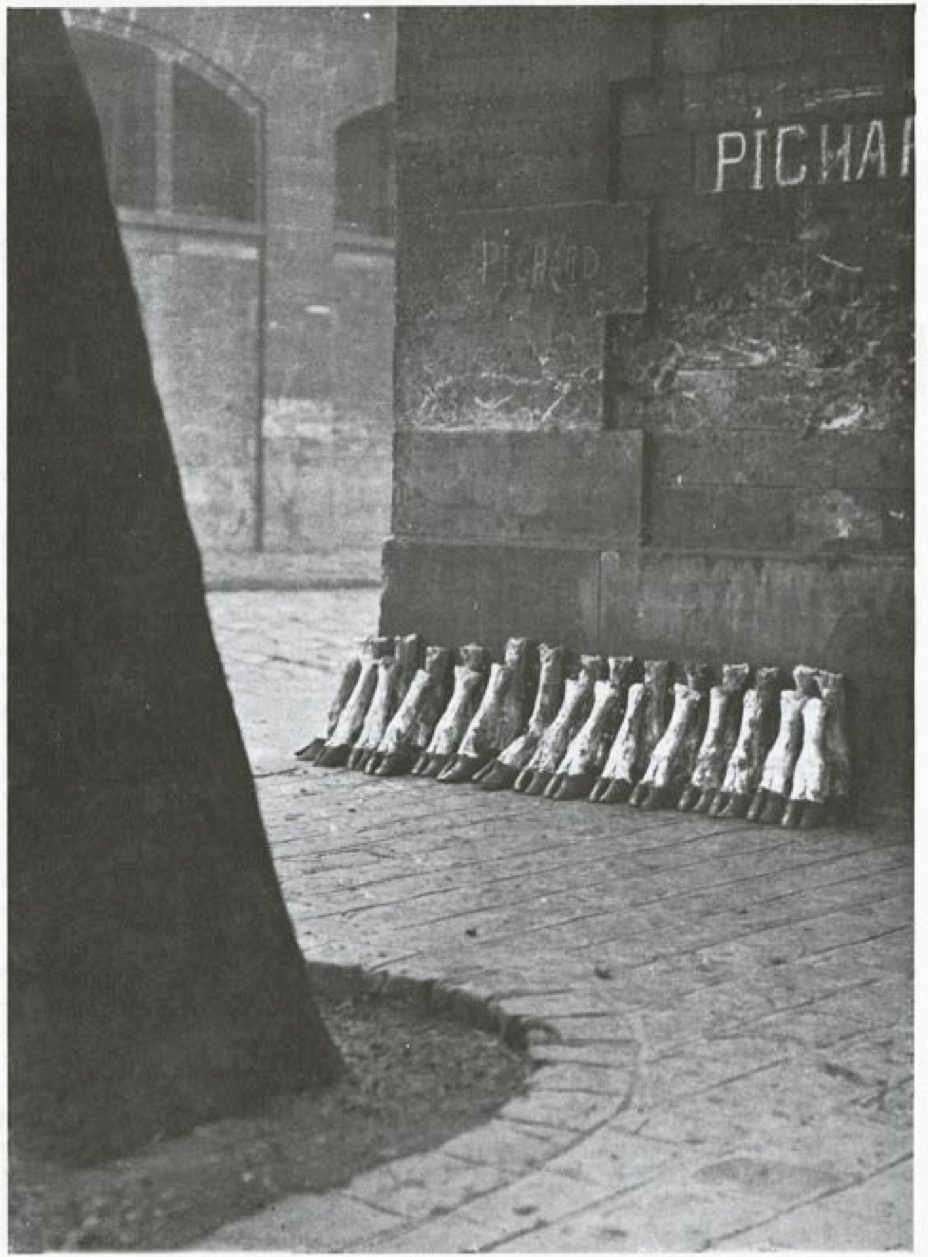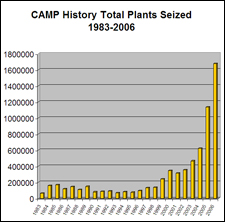“The proper and most equitable remedy”
Posted on | June 18, 2010 | No Comments

A typical entrance to a ranch in Spring Valley, Nevada. Yesterday's decision by the Nevada Supreme Court leaves 2007 awards of Spring Valley groundwater to Las Vegas standing, but calls for the reopening of a protest period that could usher in a powerful new generation of pipeline opponents. Photo: Emily Green
UPDATED: The Nevada Supreme Court yesterday issued a revision of a January ruling in which it again concluded that the State Engineer of Nevada violated due process rights of protestors by failing to hold timely public hearings on a plan by Las Vegas to tap rural groundwater. As remedy, the Court called for a new protest period that could refresh the ranks of pipeline opponents. However, the decision stopped short of voiding water awards already made to Las Vegas.
In 1989, the Las Vegas agency that is now part of the Southern Nevada Water Authority made sweeping applications to drill for rural Nevadan groundwater in dozens of basins, some almost 300 miles away. Yet hearings before the State Engineer for supplies from key valleys did not commence until 2006. By this time many protestors had been forced out of business, moved or died.
Tags: chance of rain > Great Basin Water Network > pipeline > Southern Nevada Water Authority
The de-monstering of tamarisk
Posted on | June 17, 2010 | 3 Comments
 The USDA Animal and Plant Health Inspection Service this week ceased release and transport of the Chinese or salt cedar leaf beetle because of potential impact on habitat of the Southwestern Willow Flycatcher. Since 1999, the beetles have been introduced along riverbanks in more than a dozen western states to check the spread of tamarisk trees, also known as salt cedars, introduced plants that are thought to displace natives and take too much water. However, incursion by the beetles into Arizonan flycatcher territory last year prompted a lawsuit. At issue: the endangered bird nested in the acclimated tree, which in turn was increasingly being eaten by an introduced beetle.
The USDA Animal and Plant Health Inspection Service this week ceased release and transport of the Chinese or salt cedar leaf beetle because of potential impact on habitat of the Southwestern Willow Flycatcher. Since 1999, the beetles have been introduced along riverbanks in more than a dozen western states to check the spread of tamarisk trees, also known as salt cedars, introduced plants that are thought to displace natives and take too much water. However, incursion by the beetles into Arizonan flycatcher territory last year prompted a lawsuit. At issue: the endangered bird nested in the acclimated tree, which in turn was increasingly being eaten by an introduced beetle.
 The decision to halt release of the beetle (Diorhabda elongata) comes on the heels of a series of reports finding that the threats posed by tamarisk to the water supply have been overblown while the plant’s benefits were obscured by the politics of drought. Last year, “The Monstering of Tamarisk” by Arizona State University biologist Matthew Chew characterized the massive federal tamarisk eradication effort as having taken on a life of its own, while a team from the University of Arizona and US Geological Survey reported in Southwest Hydrology that tamarisk “water use is well within the range of native species” such as cottonwoods and willows. This was echoed in April by an USGS study.
The decision to halt release of the beetle (Diorhabda elongata) comes on the heels of a series of reports finding that the threats posed by tamarisk to the water supply have been overblown while the plant’s benefits were obscured by the politics of drought. Last year, “The Monstering of Tamarisk” by Arizona State University biologist Matthew Chew characterized the massive federal tamarisk eradication effort as having taken on a life of its own, while a team from the University of Arizona and US Geological Survey reported in Southwest Hydrology that tamarisk “water use is well within the range of native species” such as cottonwoods and willows. This was echoed in April by an USGS study.
The USDA notice via Richard Spotts. Click here for a presentation with good photographs about the impact of beetles in the Lower Colorado by Larry Stevens of the Grand Canyon Wildlands Council.
This post has been updated.
‘Let there be shade’
Posted on | June 15, 2010 | 3 Comments
 Frances Anderton of the NPR affiliate KCRW today dedicated the first spot of her design show DNA to not so much look but squint at the lack of shade in Los Angeles. Guests included Jane Houlihan of the Environmental Working Group on sunscreens, Emily Green of Chance of Rain (also known as me) on the need for trees in schools and streets, urban planner James Rojas of Gallery 727 on how shade could redefine transport and architect Lorcan O’Herlihy on shade for bus stops. Quite aside from the rank puffery of pointing out my own appearance, it’s a smart visit to an important issue. To listen, click here.
Frances Anderton of the NPR affiliate KCRW today dedicated the first spot of her design show DNA to not so much look but squint at the lack of shade in Los Angeles. Guests included Jane Houlihan of the Environmental Working Group on sunscreens, Emily Green of Chance of Rain (also known as me) on the need for trees in schools and streets, urban planner James Rojas of Gallery 727 on how shade could redefine transport and architect Lorcan O’Herlihy on shade for bus stops. Quite aside from the rank puffery of pointing out my own appearance, it’s a smart visit to an important issue. To listen, click here.
Pot growing season in California
Posted on | June 15, 2010 | No Comments

Click on the graphic to be taken to the campaign that put marijuana control up to a vote in California in November 2010
… is in full swing, according to the Campaign Against Marijuana Planting. However, this year, shortly after autumn harvest, on November 2, 2010, the opportunity to extend controls now used for alcohol to marijuana, or Cannabis sativa, will come before California voters. Here is a chance to aim for the civility of the Dutch. Proponents of the plan point to the potential to fill public coffers and empty state prisons. Less obvious benefits include an end to growers splashing herbicides on public land and possibly even a stop to water wrangling by marijuana farmers, though given the attitude of legit farmers to water reporting, that might truly be a pipe dream. Labels as to potency would certainly be a public service. For those who want to learn more, some links, with a warning. The Office of the Attorney General Campaign Against Marijuana Planting hasn’t updated its graphics for four years (below, click to enlarge). Perhaps this is because, read critically, the ever-increasing nature of the hauls might not lead one to conclude that the program has been a success. This was certainly at issue when USA Today reported on CAMP in 2005. For an activist assessment, click here to read the Marijuana Policy Project on CAMP in 2008. For further reading and copious links, go to NORML California, and, because this is primarily a water blog, click here for a funny item from On the public record blog about the water needs of hemp.
Update 6/17/2010: KPCC’s AirTalk carries debate of the marijuana initiative. Panelists include retired Superior Court Judge Jim Gray, Los Angeles County Sheriff Lee Baca and Oakland City Attorney John Russo. Remarks caught from the radio in the background: “Marijuana is the largest cash crop in the country.” — Jim Gray. “Marijuana is like an oil slick in the brain.” — Lee Baca. To catch the show this afternoon from KPCC’s website, click here.
Interim phantom
Posted on | June 15, 2010 | No Comments

The slaughterhouse at La Villette, 1929. Photo: Eli Lotar. Source: Documents magazine, November 1929.
Austin Beutner, interim general manager of the Los Angeles Department of Water & Power, wants to sell assets and the department headquarters rather than ask for rate increases to pay for renewable energy reports the Los Angeles Times. The Times describes Beutner as the fifth general manager in three years, a break from the standing bio note that he’s also the ninth GM in 10 years.
Given that all GMs seem to be interim, if the department does sell its headquarters, it could always relocate the general manager’s office to Farmer John in Vernon. Click here for a sketch Beutner budget released last week, or here for KPCC’s Molly Peterson’s preview of today’s plans for specific divestments. LA Observed says Beutner and City Council president Eric Garcetti will appear today on KPCC’s Patt Morrison show.
UPDATE: Click here for the interim general manager’s “long term plan.”
« go back — keep looking »




